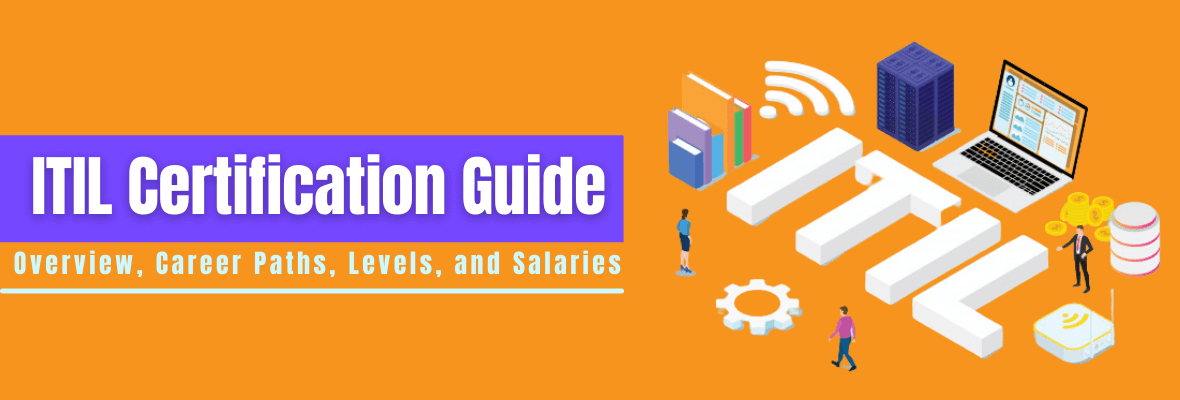ITIL Certification Guide: Overview, Career Paths, Levels, and Salaries
A combination of elite IT practices that emerged in the 80s and later found its way to the modern-day IT industry, ITIL (IT Infrastructure Library) remains unchallenged as the most systematic approach to IT service management. It has caught the eye of larger organizations and start-ups alike and continues to be one of the most widely adopted sets of practices in IT ecosystems.
If you have your heart set on becoming a certified ITIL professional, here is an exhaustive guide for you to understand everything about the certification, different levels, career paths, and salaries.
What is ITIL?
ITIL is a collection of best practices to deliver IT services, which was first developed by the UK government’s Central Computer and Telecommunications Agency (CCTA). It was essentially a compilation of the best IT practices acquired from different sources that have now been streamlined to fit the needs of the present-day demands of the industry.
IBM claims that this compilation predominantly borrowed insights from its four-volume publication called A Management System for Information Systems also called the Yellow Books. Today, the framework is owned by AXELOS, which is a union of Capita and the UK government’s Cabinet Office.
ITIL is not a rigid roll call of tasks that, when not followed, derail the working process of an organization. It is rather a set of suggestions that can enhance the quality of the end solutions they produce. Organizations have the liberty to evaluate the ITIL practices and handpick the ones that best suit their needs and goals. Some of the most popular organizations that use the ITIL framework are Microsoft, Sony, Disney, Fujitsu, Walmart, and Toyota.
What Are Some of the Key Concepts in ITIL Framework?
ITIL framework constitutes a series of practices that are applied by the IT team to deliver IT-enabled services. For effective management of IT services, you need to understand the ins and outs of all IT-related concepts and processes. The quality of the services you deliver depends on your understanding of the same.
Service and Value
How does ITIL define a service? According to ITIL Practitioner Guidance published by AXELOS, a service is a means of delivering value to customers by facilitating outcomes that customers want to achieve without the ownership of specific costs and risks.
Value drivers depend on the priorities and preferences of customers. Most services deliver value at the point where the customer consumes the service.
In ITIL, the value of service has two aspects:
1. Utility – Does the service deliver what the customer needs?
2. Warranty – Are the services available when the customer needs them?
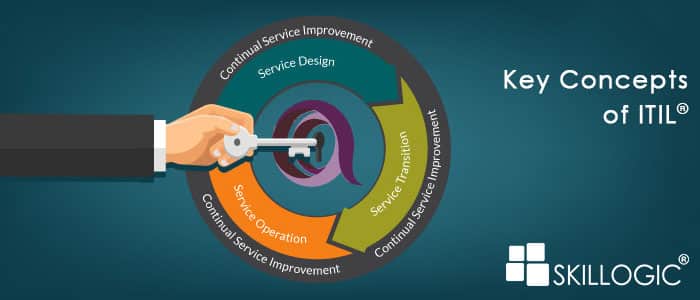
Source: SkillLogic
Outcome
What is an outcome? “Outcome” is perhaps the most important terminology in the IT Service Management lexicon. In ITIL Practitioner Guidance, an outcome is defined as the result of carrying out an activity, following a process or delivering an IT service, etc. It refers to both intended and actual results. But successful outcomes of an IT team do not always mean successful outcomes for the organization.
Functions, Processes, and Roles
One of the main objectives of IT is to assist the organization in achieving its goals. This is exactly what the ITIL framework does; it helps the IT team deliver services that align with the business needs.
An organization at its core can be broken down into functions, processes, and roles. Here is a detailed look at each of them.
1) Functions – A function is a combination of people who perform a certain activity and the equipment they use to accomplish it. Function refers to the specialized unit involved in performing an activity. The quality of the function directly impacts the quality of the outcome. Functions are necessary to increase the efficiency in performance.

Source: GreyCampus
2) Processes – A process is a collection of interrelated activities that, when executed in a coordinated manner, helps you meet your objectives. A process has the following features:
- Processes have very specific inputs and outputs.
- Processes are initiated as a response to a particular event.
- Processes are measurable.
- Processes have a receiver of the output.
3) Role – A role is a set of responsibilities, authorizations, and activities that is delegated to an individual or an entire team. The roles in ITIL are defined for each process to ensure that all the vital tasks are performed while carrying out a process.
Different Versions of ITIL
ITIL has undergone several amendments over the years. The first iteration came out in the 1980s, which was then followed by the second version that was launched in 2001. Microsoft employed this version of ITIL along with some changes to develop their Microsoft Operations Framework (MOF). This resulted in the emergence of ITIL version 2, or ITIL V2, which had 10 main processes and a service desk.

Source: EasyVista
ITIL V3 came out in 2007 and strived to integrate business goals and IT. This version had 26 different functions and processes. In 2011, this version was revised to rectify the errors and inconsistencies in the version that preceded it.
The current version of ITIL is called ITIL V4 and was launched in 2019. It focuses on giving practical guidance to IT teams, especially in collaborative environments. This version makes it easy for organizations to align ITIL better with DevOps, Agile, and Lean methodologies. With V4, ITIL embraced a more holistic philosophy towards IT service management.
The most popularly used versions of ITIL today are ITIL V3 and V4. ITIL V4 includes some practices and new materials about business integration to make it better than the previous version.
What Are the Benefits of Getting ITIL Certification in 2021?
What is the use of ITIL certification? The ITIL certification was crafted for the IT service industry and helps IT professionals gain enhanced knowledge of IT infrastructure, IT processes, and IT’s role in adding value to the business.
Here are some of the benefits of getting ITIL certified:
1. ITIL-certified professionals have better job opportunities
A very large number of organizations are dependent on ITIL methodologies to deliver IT services. The rapidly increasing demand for Cloud and Big Data strategies within organizations has also significantly hiked the demand for this framework. This has created a huge demand for ITIL-certified professionals in the market; an ITIL-certified IT professional receives more attention from recruiters than their non-certified counterparts.
2. ITIL-certified professionals add great value to the organization
For organizations to keep up with innovations and tough competition in the market, they need to get rid of outdated software and hardware practices. An ITIL-certified professional can implement the right set of ITIL practices to do the same. He or she learns from mistakes and gives due attention to performance indicators.
The ITIL framework unites an IT team with a common language; a unified approach and a common set of tools can enhance the collaboration of IT team members. The emergence of this framework has removed the need for lengthy learning cycles. ITIL framework also gets rid of redundancy, strengthens core processes, and optimizes resource utilization, thus eliminating chaos.

Source: SlideShare
3. ITIL certification leads to better pay scales
The labor market is constantly aligning itself with the growing demands in technology, because of which there is a great scarcity for talents. With more and more organizations adopting the ITIL framework, ITIL-certified professionals are one of the most sought-after candidates in the IT industry. ITIL certification can better your career prospects, increase your opportunities, and most importantly, hike your salary. A certified ITIL professional can earn up to $100,000 with slight variations in different localities and nations.
4. ITIL certification helps you see the big picture
ITIL certification equips you to always strive to have a holistic view of business processes and functions. With this certification, your perspectives are no longer confined to your job description; you are rather encouraged to look beyond your job role and see where your work fits in the organization. This will help you contribute better to the growth of the organization.
5. ITIL certification increases your competency
ITIL is a combination of the best practices in IT service management. The certification helps you acquire all the skills you need to deliver high-quality solutions. It helps you have a better understanding of the ITIL framework, its concepts, processes, tools, and techniques. You will also learn to focus on customer satisfaction, user experience, productivity, collaboration, and transparency.
6. ITIL certification sets you on par with global ITSM standards
The ITIL framework is designed for IT administrators to become business service partners rather than just back-end support. ITIL guidelines are refined to meet the global ITSM standards including ISO/IEC 20000; certified ITIL practitioners are capable of using the ITIL framework to rightly respond to the outages in services and infrastructure. They are capable of using the right ITSM strategy to identify all the technical data in the organization and understand how it impacts the goals of the organization.
Some Points to Note in ITIL Certification
ITIL certification constitutes a set of qualifications that are spread across the key areas in the ITIL framework. An aspiring ITIL practitioner needs to undergo formal education in ITIL practices in order to become certified.
Here are some important points to note regarding ITIL certification:
1. Only individuals can get ITIL certification; currently, there are no certifications for businesses or organizations. AXELOS only certifies individuals who want to excel in different areas of the ITIL framework. Employees can choose people from their candidate pool based on their requirements.
2. There is a three-tier structure maintained by AXELOS to safeguard the validity of ITIL examinations:
- AXELOS – The ITIL certification program is owned by AXELOS. It further gives accreditation to examination institutes and allows them to issue ITIL certifications.
- Examination Institutes (EIs) – EIs are accredited by AXELOS to issue ITIL certifications to candidates who pass the ITIL examination. They in turn authorize training organizations who want to offer ITIL certificates.
- Accredited Training Organizations (ATOs) – ATOs supervise ITIL exams and administer them to aspiring individuals.
3. ITIL is currently in a transition period. It is offering exams in ITIL V3 and simultaneously reworking its examination pattern to accommodate the practices in ITIL V4.
Different Levels in ITIL Certification
ITIL V3 certification consists of the following levels:
1. ITIL Foundation Certification
The ITIL Foundation certificate is for IT practitioners who require a basic understanding of the ITIL framework and how it can be employed for better IT Service Management. This course focuses on the basic concepts and elements of the ITIL framework that can be used to improve the quality of their functions.
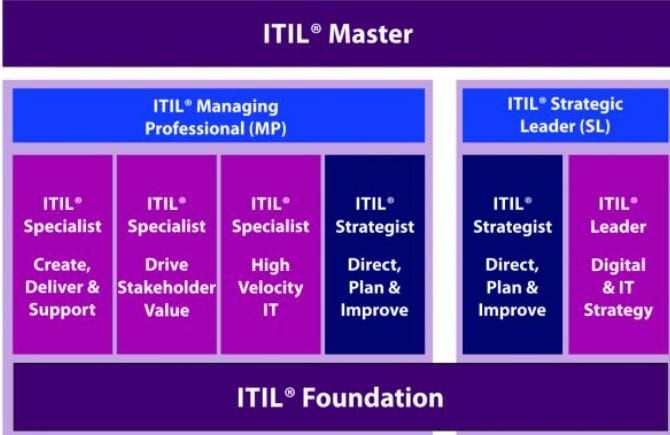
Source: Axelos
2. ITIL Practitioner Certification
The ITIL Practitioner certification has a very practical approach to ITIL framework education. It helps IT professionals implement the best ITIL practices to contribute to the goals of the organization. This certification focuses on the following key areas:
- Continual service improvement
- Organizational change management
- Communication
- Measurement and metrics
3. ITIL Intermediate Certification
The ITIL Intermediate level certification is for IT professionals who want to take divergent ITIL paths. The intermediate level is divided into two module paths: service capability modules and service lifecycle modules. Based on the career path an IT professional seeks, he or she can choose the course with either of these modules.
4. ITIL Expert Certification
The ITIL Expert level certification is meant for IT professionals who want to demonstrate their knowledge of the complete framework. These professionals should have already undergone training in other ITIL certification courses. To qualify for Expert level certification, candidates must have an ITIL Foundation certification and a minimum of 17 credits from ITIL Foundation and Intermediate certifications.
5. ITIL Master Certification
An ITIL Master-certified IT professional can implement ITIL practices and principles in business environments. The candidates of this certification need an ITIL Expert certification and should have worked in an ITSM leadership role for a minimum of 5 years.
ITIL V4 is comprised of the following certification levels:
1. ITIL 4 Foundation
This course was launched on February 28, 2019, and is a revised version of the ITIL V3 Foundation course. It covers Lean, Agile, and DevOps concepts as well as the seven guiding principles and basic concepts of ITIL. The co-creation of value using customer-focused products is another key area that this course addresses.
2. ITIL 4 Managing Professional
The ITIL 4 Managing Professional certification is a new certification course launched by AXELOS. ITIL practitioners with an ITIL Expert certification can acquire this credential by completing the ITIL 4 Managing Professional transition module.
The following are the modules to obtain for this certification:
- ITIL 4 Specialist: Create, Deliver, and Support
- ITIL 4 Specialist: Drive Stakeholder Value
- ITIL 4 Specialist: High-Velocity IT
- ITIL 4 Strategist: Direct Plan and Improve
- ITIL 4 Strategic Leader
This certification was launched in the first half of 2020 and has two modules: ITIL 4 Strategist: Direct Plan and Improve and ITIL 4 Leader: Digital and IT Strategy. The ITIL 4 Strategic Leader certification empowers an IT professional to demonstrate their understanding of IT’s influence on business strategies.
3. ITIL 4 Master
If you are an aspiring ITIL 4 Master, you need to have acquired both ITIL 4 Strategic Leader and ITIL Management Professional certifications. To achieve this certification, you need to be able to explain your ability to apply the ITIL principles, techniques, and methods.
4. ITIL Certification Costs
ITIL certification costs can vary based on the trainer as well as the country you are in. Here is what the certification costs look like in the US:

How to Transition from ITIL V3 to ITIL V4?
Though ITIL V3 certification is still valid, candidates are recommended to transition to the new scheme and learn the core concepts of the updated version; ITIL V3 certifications and exams will not be valid after 2021. Since there is a large amount of revision in the new version, it is necessary to demonstrate your understanding of the updates before you get certified.
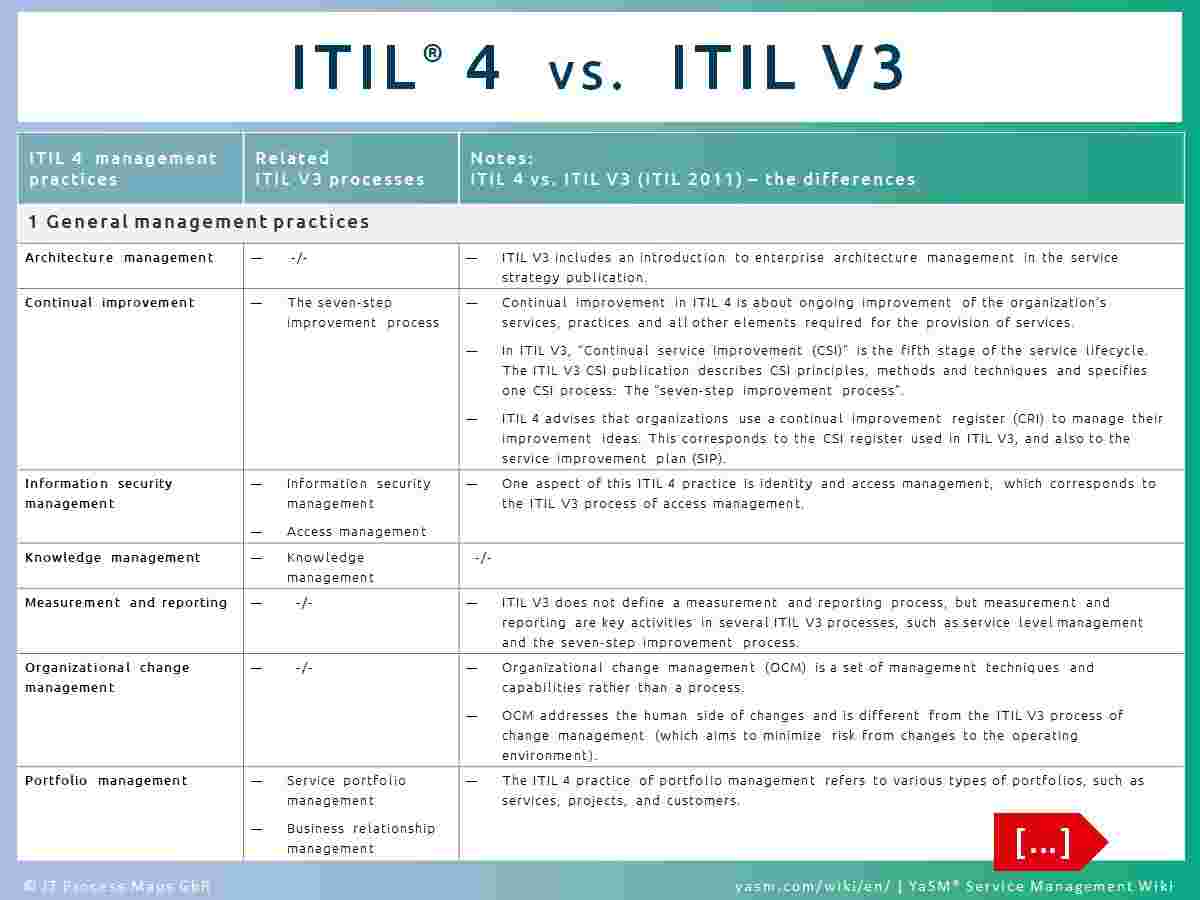
Source: YaSM
So what's new in ITIL Version 4? ITIL V4 is all about focusing on the best of all IT practices, such as collaboration and organization-wide effective communication. It also emphasizes the significance of increasing flexibility, customization, and, most importantly, the integration of Agile and DevOps software delivery. Some of the definitions have been revised to complement the current service models.
ITIL V4 also helps ITSM to accommodate the transition from the CapEx model to the OpEx one. It assists IT ecosystems to smoothly transition to the new model while being aligned with business requirements.
The most significant change is perhaps the scrapping of the V3 lifecycle and the adoption of the Service Value System (SVS).
ITIL V3’s lifecycle was based on the traditional waterfall method and had 5 stages:
1. Service Strategy – Strategy defines policies and prioritizes the services that need to be offered to customers.
2. Service Design - Services are designed to align with the goals of the organization as well as the policies defined during the strategy phase.
3. Service Transition – The transition phase constitutes building, testing, and deploying services.
4. Service Operation – In the operation phase, all operations that are required to keep the service running are performed within quality parameters. The generation of value is the most important event in this phase.
5. Continual Service Improvement – In this phase, the IT team continually improves the quality of the services and tries to make sure that the outcomes are aligned with the goals of the organization.
In ITIL V4, the Service Value System defines how all activities and components need to work together to accomplish objectives. It includes the following elements:
1. Service Value Chain (SVC) – The Service Value Chain is the oath across which the service value stream flows from demand to value.
2. ITIL Practices – ITIL V4 has a more holistic approach to IT service management because of its shift from processes to practices. This expands the scope of work as well as goals.
3. ITIL Guiding Principles – The guiding principles are crafted to guide an IT professional or team during major decision-making processes. These principles also promote innovative ways of thinking.
4. Governance – Governance is that part of the revised scheme that enables the IT team to align their activities with business objectives.
5. Continual Improvement – Continual improvement is employed across all areas of IT service management. Professionals are encouraged to identify areas of improvement, collaborate, and seize opportunities to make things better.
How do you make the transition? The credits you have acquired from your previous ITIL certification training can definitely add value to your ITIL journey. According to AXELOS, candidates need to acquire 17 credits from ITIL V3, which will make them eligible to take the ITIL 4 Managing Professional Transition module. This single course with a single examination is recommended by AXELOS for a smooth transition from ITIL V3 to ITIL V4.
Different Job Roles in ITIL
Every IT organization needs to structure its processes, define its roles, and assign responsibilities accordingly. The roles in ITIL Service Management require a specific skill set and competency.
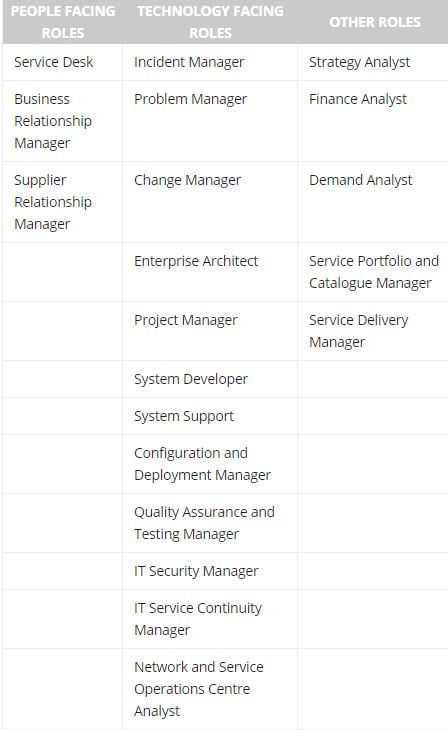
Source: BMC
Here are some of the job roles in ITIL Service Management:
1. People-facing Roles
- Service Desk
The service desk role acts as the single point of contact between customers and services. It deals with service requests and manages communication with the users. The service desk role is also responsible for providing the first-line investigation and for conducting customer surveys.
- Business Relationship Manager
A business relationship manager plays multiple roles in an IT environment, including that of a service level manager and an account manager. It is their responsibility to maintain a fruitful relationship between the service provider and the customer.
- Supplier Relationship Manager
A supplier relationship manager acts as an interface between the IT department and the supplier of services and assets. He or she makes sure that the value for money is gained from all suppliers and contracts.
2. Technology-facing Roles
- Incident Manager
Incident managers are responsible for the coordination of major incidents. It is their responsibility to produce management information as well as to develop and maintain incident management systems.
- Problem Manager
A problem manager is next in line after the incident manager; solved problems are passed on to the problem manager for follow-ups. He or she investigates the root cause of the problem and works toward achieving a permanent solution.
- Change Manager
ITIL change management is all about coordinating the review and approval of changes in IT services and structure. Change managers act as the interface between change management and other processes in the IT environment.
- Project Manager
Project managers define and maintain project management standards and provide the resources that are necessary for the completion of IT projects. A project manager is actively involved in service design and service transition stages.
- Enterprise Architect
An enterprise architect coordinates and designs all the technology involved; he or she makes sure it is resilient, secure, and meets all the present and future IT requirements of the organization. This professional is also expected to develop proactive solutions to improve the overall IT design and infrastructure.
- Systems Developer
A systems developer is involved in software development and systems configuration. From designing the release package to providing support to deployed services, a systems developer is an integral part of the ITIL service management team.
- Systems Support
Systems support serves as the second line support role; they take part in the development of new services during the service design and transition phases. It is a system support professional’s responsibility to analyze risks and provide countermeasures.
Salaries and Career Path
ITIL is now implemented in a wide range of industries, including healthcare and education. While the certification is the most beneficial for IT professionals at the mid-and senior-management levels, those at the junior levels can also advance their career with an ITIL certification.
With the widespread adoption of ITIL in large as well as small organizations, the industry demand for ITIL-certified professionals is on the rise. A certified ITIL professional can earn 15 percent more than a non-certified professional; the remuneration is directly influenced by the level of certification.

Source: PayScale
Here is a list of some of the common ITIL roles and their average annual salaries:
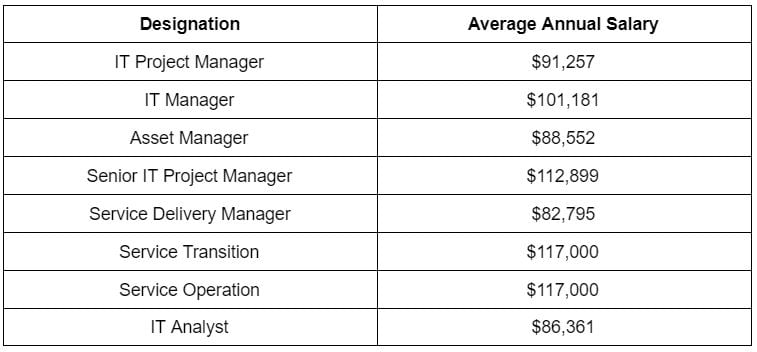
With quality experience and a willingness to learn, the career path of an ITIL-certified professional can be very rewarding. Here is what the growth trajectory of an ITIL-certified professional look like:
- With two years of experience, an ITIL-certified professional can become a process coordinator. This applies to professionals who have Foundation to Intermediate level certifications. Configuration Analyst, Change Manager, and Incident Manager are some of the important roles in this spectrum.
- With eight years of relevant experience, an ITIL-certified professional can rise to a managerial position (mid-management level). Problem Manager, Release Manager, and Service Desk are some of the roles that fall into this category.
- With ten years of experience in the industry, an ITIL-certified professional can function in a consulting capacity. The ITIL consulting role is the highest paid role and demands strong observation and problem-solving skills.
There are very compelling ITIL certification benefits for IT professionals. But how does ITIL benefit an organization? ITIL can significantly contribute to the quality of a business; a smooth-running organization with a healthy IT infrastructure performs its job effectively. The ITIL framework assists organizations by reducing costs, improving IT services and customer satisfaction, increasing productivity, and raising the overall standards of the organization.
ITIL is an ever-evolving set of practices that will continue to shape the IT industry. If you are a passionate IT professional, an ITIL certification course can help you easily tread the path to success. GreyCampus is a leading provider of ITIL Foundation training and certification. It guarantees a two-day bootcamp along with 25 PMI PDUs. The course offers one-year of access to audio/video lectures and two simulated exams to help you prepare for the certification exam.
